Lesson 10
What Is the Same?
Lesson Narrative
In this lesson, students explore what it means for shapes to be “the same” and learn that the term congruent is a mathematical way to talk about figures being the same that has a precise meaning. Specifically, they learn that two figures are congruent if there is a sequence of translations, rotations, and reflections that moves one to the other. They learn that figures that are congruent can have different orientations, but corresponding lengths and angle measures are equal. Agreeing upon and formulating the definition of congruence requires careful use of precise language (MP6) and builds upon all of the student experiences thus far in this unit, moving shapes and trying to make them match up.
As they work to decide whether or not pairs of shapes are congruent, students will apply MP7. For shapes that are not congruent, what property can be identified in one that is not shared by the other? This could be an angle measure, a side length, or the size of the shape. For shapes that are congruent, is there any way to tell other than experimenting with tracing paper? In some cases, like the rectangles, students discover that looking at the length and width is enough to decide if they are congruent.
In elementary grades, deciding if two shapes are the “same” usually involves making sure that they are the same general shape (for example, triangles or circles) and that the size is the same. As shapes become more complex and as we develop new ways to measure them (angles for example), something more precise is needed. The definition of congruence here states that two shapes are congruent if there is a sequence of translations, rotations, and reflections that matches one shape up exactly with the other. This definition has many advantages:
- It does not require measuring all side lengths or angles.
- It applies equally well to all shapes, not just polygons.
- It is precise and unambiguous: certain moves are allowed and two shapes are congruent when one can be moved to align exactly with the other.
The material treated here will be taken up again in high school (G-CO.B) from a more abstract point of view. In grade 8, it is essential for students to gain experience executing rigid motions with a variety of tools (tracing paper, coordinates, technology) to develop the intuition that they will need when they study these moves (or transformations) in greater depth later.
Learning Goals
Teacher Facing
- Compare and contrast (orally and in writing) side lengths, angle measures, and areas using rigid transformations to explain why a shape is or is not congruent to another.
- Comprehend that congruent figures have equal corresponding side lengths, angle measures, and areas.
- Describe (orally and in writing) two figures that can be moved to one another using a sequence of rigid transformations as “congruent.”
Student Facing
Let’s decide whether shapes are the same.
Required Materials
Required Preparation
Colored pencils are supposed to be a usual part of the geometry toolkit, but they are called out here because one activity asks students to shade rectangles using different colors.
Learning Targets
Student Facing
- I can decide visually whether or not two figures are congruent.
Glossary Entries
-
congruent
One figure is congruent to another if it can be moved with translations, rotations, and reflections to fit exactly over the other.
In the figure, Triangle A is congruent to Triangles B, C, and D. A translation takes Triangle A to Triangle B, a rotation takes Triangle B to Triangle C, and a reflection takes Triangle C to Triangle D.

Print Formatted Materials
For access, consult one of our IM Certified Partners.
Additional Resources
| Google Slides | For access, consult one of our IM Certified Partners. |
|
| PowerPoint Slides | For access, consult one of our IM Certified Partners. |